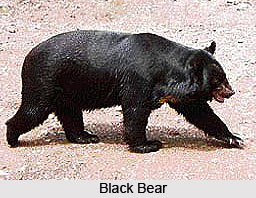 The Indian Black Bear is also called Asiatic Black Bear, Tibetan Black Bear, Himalayan Black Bear and Moon Bear. From the nose to the tail, the bear measures four to six feet. They have small eyes, rounded ears, long snout, a large body, short tail and shabby hair that separates it from other types of bears. The other physical differences between other bears and the Indian black Bear are the shoulder hump, a furry rear instep, a concave facial contour, small sharp claws and narrow ears. The Indian Black bear also has a whitish V-shaped breast spot, which is not found in any other bear species in India.
The Indian Black Bear is also called Asiatic Black Bear, Tibetan Black Bear, Himalayan Black Bear and Moon Bear. From the nose to the tail, the bear measures four to six feet. They have small eyes, rounded ears, long snout, a large body, short tail and shabby hair that separates it from other types of bears. The other physical differences between other bears and the Indian black Bear are the shoulder hump, a furry rear instep, a concave facial contour, small sharp claws and narrow ears. The Indian Black bear also has a whitish V-shaped breast spot, which is not found in any other bear species in India.
The average weight of a black bear is nearly two hundred and twenty to four hundred and eighty pounds. The females weigh nearly one hundred and ten to two hundred and seventy five pounds. Black bears have a coloured vision and their eyesight is very sharp. Even their ability to smell is also highly developed.
The Indian Black bear are omnivores. Their diet varies from season to season and on the availability of the food. In the fall season they have acorns, chestnuts, walnuts and other fatty foods. During the season they consume bamboo, raspberry, hydrangea and other plants along with rodent`s caches of acorns. They have raspberries, cherries, grases and ants during the summers.
The Indian Black Bear mate from late May to early July. They give birth to two cubs at one time, which stay with their mother for nearly one and a half years. They are found in the Himalayan foothills at a height of less than 3,750 meters. The animal has been listed as one of the endangered animal since the population is rapidly declining.



















